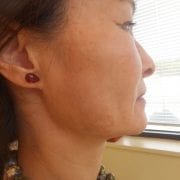How Chemical Peels Rejuvenate the Skin

Sun exposure can cause discoloration of the skin as well as roughness and wrinkling. This damaged skin can be repaired to a large degree with a variety of rejuvenating treatments.
One of the methods that restores the skin’s natural beauty without significant downtime is a chemical peel. Peels are a great way to brighten the skin and reduce discoloration.
History of Chemical Peels
Interestingly these procedures have been performed for centuries. The ancient Egyptians used acids to peel the skin as early as 1550 B.C. Dermatologists have been doing the modern day version for more than half a century. The procedures we use today have been greatly refined, and so has our approach to using them.
Modern Chemical Peels
Peels can be tailored for skin type and the type of skin damage. It’s not a “one size fits all approach to anti-aging. Peeling agents include an alphabet soup of some combination of the following: salicylic, retinoic, mandelic, phytic, and tricholoracetic acids. We choose an agent or agents based on the tone and condition of the skin as well as the desired outcome.
Today’s chemical peels often infuse the skin with ingredients that encourage its own natural processes such as building collagen to diminish wrinkles and improve tone. They can also be combined with other procedures such as microneedling to enhance the penetration of active agents.
Different Types of Chemical Peels
Here’s a primer on peels. A light peel, commonly called a lunchtime peel, gently exfoliates only the outer layer of skin. This treatment can improve mild discoloration as well as refresh the face, neck, chest or hands. Regular light peels for acne work well with other treatments and can help reduce the need for prescription oral antibiotics. Light peels are also an excellent solution for patients of color looking to lighten the skin.
To get the results you seek from a light peel, you will need multiple treatments, depending on your goals. Melasma or hyperpigmentation on the face will require several sessions of chemical exfoliation to eliminate the pigment.
A medium peel penetrates the outer and middle layers of skin to improve age spots, fine lines and wrinkles, freckles and moderate skin discoloration. It also can be used to smooth rough skin and treat precancerous skin growths such as actinic keratoses.
Deeper peels are also designed to penetrate the middle layer of skin to remove moderate lines, age spots, freckles and shallow scars.
Preparing for a Chemical Peel
Preparation for a peel is as important as the peel itself. You may be given instructions on a skin care plan- especially if you have darker skin tones- for the 2-4 weeks preceding a peel. After your peel you we will tell you how to care for your skin, when it’s safe to begin wearing makeup and what you should be using to maintain the benefits of your peel.
Peels are a customizable approach to healthy anti-aging and a natural aesthetic.





